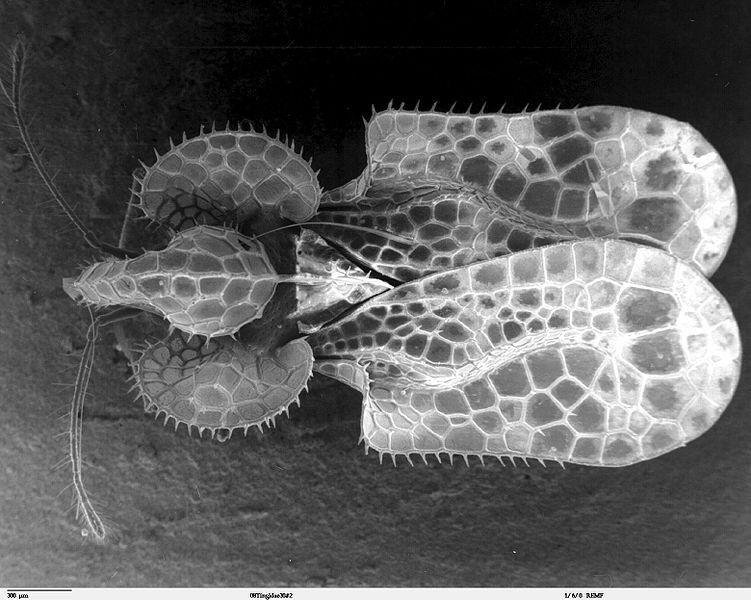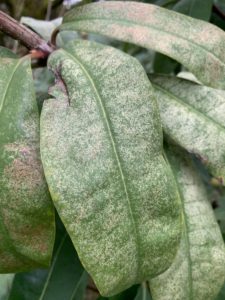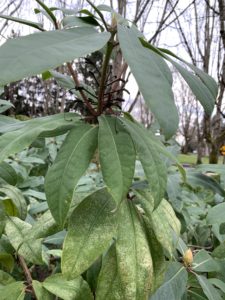
Are you wondering why some of your rhododendrons and azaleas are taking on a shabby whitish-yellow look as if some graffiti artist snuck into your yard and airbrushed them with paint while you were asleep? Or maybe you think they sport a pale coat because you neglected to fertilize them, or maybe…. Well, it’s none of the above. These ornamental shrubs look this way because there’s a new villain in town that’s literally sucking the life out of your plants, and it’s called the lace bug, and it’s not going away. Let’s introduce you to your new, not so friendly neighbor is and what you can do about it this pesky little insect.
What is azalea and rhododendron lace bug?
The lace bug is a tiny insect that uses its piercing-sucking mouthparts to suck the sugars of the green chlorophyll out of the leaves of broadleafed evergreen trees and plants. This action causes significant damage to the leaves by reducing their ability to produce food for the plant. If the lace bug infestations is severe, this can weaken a plant thus stressing it to the point where it becomes more susceptible to other pests and diseases. We will discuss what you can do to protect your plants from this bothersome pest.
At one-tenth to three-eighths of inch long, the adult lace bugs are whitish-tan in color with a thorax (body)and transparent wings sculptured with an intricate pattern of veins that resembles lace. There are approximately 140 varieties of lace bugs in North America. The one that feeds primarily on azaleas has smoky brown markings on its wings, which distinguishes it from the pale whitish-tan rhododendron (or rhody) lace bug. The juvenile lace bugs or nymphs, which emerge in the spring, are colorless to black in color, pointed on both ends and may have spines depending upon their age.
What is the life cycle of the lace bug?
Lace bugs are a hardy creature that can overwinter under bark scales in trees. They also lay eggs along the mid-ribs on the underside of leaves that resemble crusty brown patches. Depending on the temperatures, they can emerge anytime from mid-April to early June. The warmer the spring, the earlier they will hatch.

They primarily spend their lives feeding on the underside of leaves.
What plants do lace bugs attack?
To this date, here is a list of plants that lace bugs are finding delicious. This list seems to be growing.
- Andromeda (Pieris Japonica)
- Azalea
- Firethorn (Pyracantha)
- Japanese holly
- Mountain laurel (Kalmia)
- Oregon white oak
- Rhododendrons (rhodies)
- Sycamore or London planetree
Why are lace bugs harmful to your plants?
Both lace bug adults and nymphs have hypodermic needle-like mouth parts called stylets with which they pierce the stomata (the openings on the underside of leaves which allow gaseous exchange to occur within the plant). Once penetration occurs, lace bugs suck out the chlorophyll or sap from the plant. This is literally the food with which a plant feeds itself.
A plant needs green chlorophyll to absorb light from the sun by which photosynthesis occurs, which is how it produces its food. With the loss of chlorophyll, not only does a plant lose its ability to produce food, but the lace bug eats the plant’s food as well. This decreases the plant’s vigor and causes the plant to be more susceptible to damage by other insects, diseases, unfavorable weather conditions or abiotic factors.
There is debate among scientists whether lace bug activity will kill a plant or not. Most experts say no, some say yes. In the many years that I have been treating plants against lace bug, I have yet to see a plant die directly from this pest, although I have seen a numerous plants that looked like they were about to die. However, one thing that all experts agree on is that repeated, heavy infestations of lace bugs is not good for the plant, and some experts suspect that, once the plant is heavily stressed, lace bugs along with other factors may contribute to the death of the plant. Moreover, everyone agrees that, at the very least, lace bugs diminishes the aesthetic and economic value of landscape plants, and this affects not only the pleasure that a well-manicured garden brings to people, but can lower property values as well. Once the leaves are damaged, they will not recover, but will remain in this condition until they fall off, which may take several years.
When did lace bug come into the Pacific Northwest?

Lace bugs have been a pest in the eastern U.S. for many years, but it’s a relatively new insect pest to the Pacific Northwest. It wasn’t until the summer of 2008 that this bug made its debut in Washington from whence it made its way into Oregon the next year.
What are the signs of lace bug infestation?
The sure sign that your rhodies and azaleas (and a few other broad-leaved evergreen ornamentals as well) have lace bug infestation is the varnish-like brown or black “tar” spots on the underside of the leaves of infested plants. This tar-like substance is their feces. Other than that, if you turn a leaf over, you may spot an adult lace bug or its nymph in the late spring or summer crawling around.
What are the symptoms (the plant’s reaction) of the lace bug?

The leaves of lace bug infested plants are easily identified. Wherever a lace bug has inserted its stylet and sucked the chlorophyll out of the leaf, on the top side of the leaf there is a pin-prick-sized white or yellow spot against the background of the green leaf. If the lace bug infestation is severe enough, the leaf will have a whitish-yellow stippled look. Higher populations of lace bugs can cause more severe damage on azaleas, causing the leaves to turn nearly white. On rhododendrons, severe damage may look like iron chlorosis with yellow leaves and green veins. This damage is similar to that of leafhoppers and spider mites, but differs in the fact that the underside of the leaf is covered in dark fecal spotting. Severely damaged leaves become heavily discolored and eventually dry or fall off. Heavily infested plants have a sickly yellow appearance.
Are some plants more susceptible to lace bugs than others?
In the ten years that I have been treating mostly azaleas and rhodies against lace bugs, I have noticed that some plants are more susceptible to lace bug attacks than others. There are several reasons for this. First, drought stressed plants are more susceptible to lace bug attack.
Second, plants in the sun are reported to be nearly twice as likely to be infested as those in the shade. This may be because a higher rate of natural predation occurs in the shade. Also, shade loving plants that are placed in the sun will suffer more stress, and thus less able to defend themselves against this pests.
Third, there are some varieties of azaleas and rhodies that show some resistance to lace bug. Why this is we don’t know.
Fourth, another factor impeding a lace bug from attacking the leaves of a plant are the naturally occurring hairs or trichomes that are found on the underside of some leaves. These trichomes act as a formidable barrier preventing the lace bug from inserting its stylet into the leaf.
What can you do to prevent lace bugs from attacking your plants?
Prevention is always the best medicine, and the way to do this is to maintain healthy plants in the first place. Generally pests are attracted to weak or stressed plants. It is the mandated job of pests to remove unhealthy and weak plants from the planet, thus leaving the strong and healthy ones to survive. This is called the survival of the fittest and insures that only the healthiest specimens will continue to exist. To maintain vigorous plants involves providing them with a healthy environment in which to grow. All plants need good soil with plenty of mulch, ample nutrients and water especially in the dry season. They also need room to grow (both soil volume and air space) and the right sun exposure. If they love shade, don’t plant them in the sun and vice versa.
There are also lace bug resistant varieties of azaleas and rhodies. Next time you’re in landscaping mode, learn what these varieties are and plant them.
When should you take action against lace bug?
If one chooses to use an insecticide to control lace bugs, the type of insecticide used will determine the timing. We will discuss this below.
How do you control lace bugs?
Let’s now discuss a few of the options to control lace bugs along with the pros and cons.
Topical or contact sprays. This category of pesticides can include both organic soaps and oils as well as inorganic chemical sprays. The problem with these is that you have to spray the plant multiple times (every week or two) to kill the various generations of lace bugs that will be hatching throughout the season. You will also have to spray the undersides of all the leaves, since this is where the lace bugs are. This is not an easy task! If you succeed in killing all of the lace bugs on your plants, there is still the possibility of them flying in from the yard of your neighbor who didn’t spray his plants.
While organic soap and oil sprays may not harm pollinators or other beneficial insects, broad spectrum inorganic chemical sprays, in many cases, will kill both pollinators and beneficial insects such as those that are preying on the lace bugs. This is not only detrimental to the environment, but upsets the balance of nature by killing those insects that are helpful to your cause. It’s also more costly and time consuming to either apply multiple sprays or to pay to have a professional do it.
Systemic Insecticides. This is the type of pesticide that I use in almost every situation. The problem is that there are no systemic pesticides that are both inexpensive, effective and organic. Thankfully, a little goes a long way. That is to say, that a very small dosage of chemical is very effective in killing all piercing-sucking insects including lace bugs. By using systemic insecticides, we’re not overloading the environment with large amounts of a toxic chemicals that it can’t handle.
Systemic pesticides are placed into the roots of the soil through a liquid solution, or sprayed onto the tree’s basal bark or placed directly into the trunk of the plant through injection, though the latter approach is less common. Soil injections be they through basal root drenching, basal bark sprays or injections via a soil probe is the system that I prefer. The pesticide is mixed with water, applied to the soil where it is then absorbed by the roots and moved or translocated to the leaves where it will remain for weeks or months waiting for the targeted insect to take a bite. When this happens, the insect receives a tiny dose of poison and subsequently meets its demise.
Systemics are target-specific pesticides unlike contact sprays that take a more shotgun approach to pest control. The former is more likely to take out the specific targeted pest, while the latter is more likely to kill not only the targeted pest, but also anything else that gets sprayed regardless of whether it is a detrimental or a beneficial insect.
The uptake time of systemic pesticides varies depending on the product used, the time of the year, and the type and size of the plant being treated. Usually it is a few weeks to a couple of months. This is why it’s important to get the insecticide into the plant’s system well before the insects hatch and become active. The residual affect of the pesticide also varies from weeks to months to a year or more.
A conscientious systemic pesticide applicator has to insure that he applies the product at the right time of the year so as to be affective in controlling the pest, while at the same time insuring that it won’t hurt pollinators or other beneficial insects. Timing is essential. When it comes to lace bugs, for example, it is best to apply a systemic pesticide well before or after the plant’s bloom time so as not to inadvertently poison the pollinators.
A final word
In conclusion, its important to keep several things in mind when treating plants against lace bugs. First, your plants can tolerate a few lace bugs. If at all possible, try to treat only those shrubs that are the most severely infested. Leaving a few lace bugs provides food for the beneficial insects and helps to maintain the balance of nature.
Second, with certain pesticides that have a long residual (a year or more), you might be able to treat your shrubs every other year instead of yearly.
Third, if you plan to treat your plants yourself, carefully read the label instructions of all pesticides down to the smallest detail and follow them to the letter. Following these instructions is federal law!
Fourth, if you’re not sure about something, consult a professional horticulturist or aborist who has the required training, certificates, licenses and experience to properly diagnose your plant problems and then to prescribe the right treatment. Educate yourself, and don’t be afraid to ask questions. Take personal responsibility for you ornamental trees and shrubs.

Fifth, lace bugs are likely here to stay. Learn how to manage them properly. Learn when to treat and when not to treat them. Learn how to protect your landscape in a responsible manner. Remember that our plants are an asset that adds economic value to our property.
Here’s how we can help you…
At Good News Tree Service, Inc. of Wilsonville, Oregon, we use an inexpensive systemic insecticide approach in treating lace bugs that is tender on the environment, targets only the lace bugs and not other beneficial insects, and one quick treatment lasts all year. We inject small amounts of pesticide into the soil at the base of the plant, which the plant systemically sucks up. When the pest takes a bite out of your plant’s leaves, it dies. Because the chemical is placed below the soil surface, there is no harm to people or animals.
Call to today for a free consultation or price quote.
Good News Tree Service, Inc of Wilsonville, Oregon at
(503) 682-9466
Sources of Information
- Missouri Botanical Gardens at http://www.missouribotanicalgarden.org/gardens-gardening/your-garden/help-for-the-home-gardener/advice-tips-resources/pests-and-problems/insects/lace-bugs.aspx
- PNW Pest Management Handbook (published by Oregon State University, Washington State University and the University if Idaho) at https://pnwhandbooks.org/insect/hort/landscape/hosts-pests-landscape-plants/rhododendron-rhododendron-azalea-rhododendron-lace-bug
- Robin Rosetta of Oregon State University at http://oregonstate.edu/dept/nurspest/azalea_lace_bug.htm
- University of California at http://ipm.ucanr.edu/PMG/PESTNOTES/pn7428.html
- University of Florida at http://entnemdept.ufl.edu/creatures/orn/shrubs/azalea_lace_bug.htm
- University of Georgia at https://extension.uga.edu/publications/detail.html?number=B1102&title=Control%20of%20Lace%20Bugs%20on%20Ornamental%20Plants
- Washington State University at http://hortsense.cahnrs.wsu.edu/Search/MainMenuWithFactSheet.aspx?CategoryId=1&SubCatId=4&PlantDefId=3&ProblemId=782
artist
